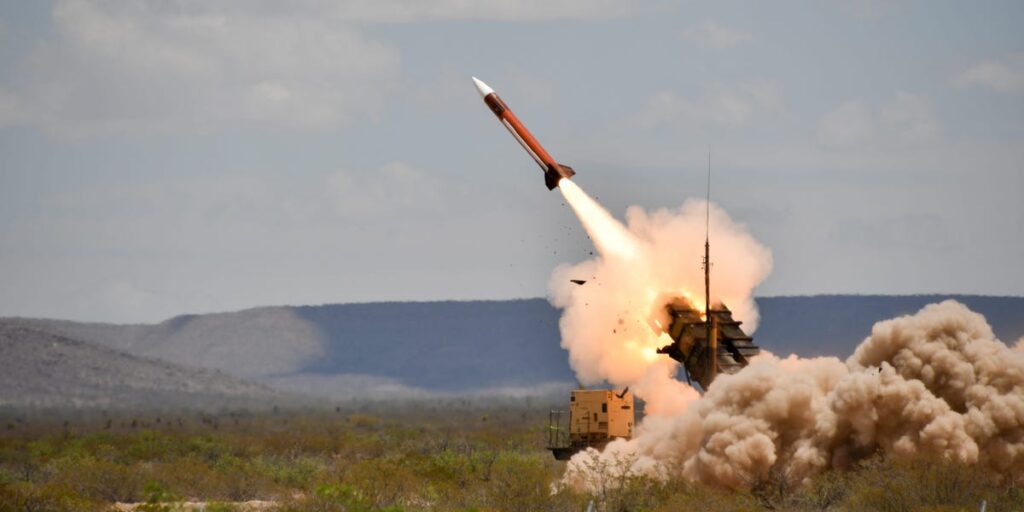
The top US general has revealed new insights into how Patriot air defense systems successfully intercepted Iranian missiles in a recent attack. During a Pentagon briefing, Gen. Dan ‘Razin’ Caine, chairman of the Joint Chiefs of Staff, described the engagement as potentially the largest of its kind in US military history.
The incident occurred at Al Udeid Air Base in Qatar, the largest US military base in the Middle East, following US bombings of three Iranian nuclear facilities over the weekend. The retaliatory ballistic missile strike by Iran targeted the base on Monday, prompting a swift defensive response by the US and Qatari forces.
Details of the Engagement
Gen. Caine, alongside US Secretary of Defense Pete Hegseth, detailed the events at a press conference on Thursday. He explained that US military leaders had received warnings of the impending Iranian attack earlier that day. Despite the advance notice, intercepting ballistic missiles remains a complex task.
The Patriot system, known for its precision and sophistication, faced numerous challenges during the engagement. It is a hit-to-kill weapon system that requires exact targeting to neutralize fast-moving threats. In this instance, the system had to contend with over a dozen incoming ballistic missiles.
“We believe that this is the largest single Patriot engagement in US military history,” Gen. Caine stated.
At Al Udeid, US forces adopted a minimum force posture, with most personnel relocated to extend the security perimeter. Approximately 44 US Army soldiers remained to operate two Patriot batteries, tasked with defending the entire base. The soldiers, ranging from a 28-year-old captain to a 21-year-old private, were deployed from US forces in South Korea and Japan.
Operational Challenges and Success
As night fell, the Patriot crews were instructed to orient their missile batteries northward, towards Iran. The control of the systems was transferred to the operators, who anticipated the attack with a tense wait.
“You know that you’re going to have approximately two minutes, 120 seconds, to either succeed or fail,” Caine remarked, highlighting the urgency of the situation.
At approximately 7:30 p.m. local time, Iran launched its missiles. As the incoming threats were detected, the Patriot systems responded with a barrage of interceptors. While Gen. Caine did not disclose the exact number of interceptors fired, he indicated that it was a significant deployment.
The joint efforts of the US and Qatari forces ensured that none of Iran’s missiles hit the base, and there were no casualties reported. The scene was described as “a lot of metal flying around,” with Patriots intercepting missiles and debris falling to the ground.
Historical Context and System Performance
The Patriot missile system, developed by Raytheon and Lockheed Martin, has a storied history. It gained fame during the Gulf War but faced criticism for inconsistent performance in subsequent conflicts. However, recent upgrades have enhanced its effectiveness, making it a crucial component of modern air defense strategies.
In recent years, the Patriot system has been extensively utilized in Ukraine, where it has been praised for its ability to counter Russian ballistic missiles, aircraft, and drones. Ukrainian officials have lauded its performance, though they have expressed a need for more units to bolster their defenses.
The Patriot system “has seen significant upgrades, and the results in combat have made it a celebrated asset,” according to military analysts.
Future Implications and Strategic Considerations
The Pentagon briefing was partly in response to media reports questioning the effectiveness of the US strikes on Iran’s nuclear facilities. While there are indications that the strikes caused substantial damage, concerns remain about Iran’s ability to rebuild and the status of its enriched uranium stockpiles.
As tensions continue to simmer in the region, the successful defense of Al Udeid Air Base underscores the importance of advanced missile defense systems like the Patriot. The event also highlights the ongoing strategic challenges faced by the US and its allies in countering missile threats from adversarial states.
Looking ahead, military experts suggest that continued investment in missile defense technology and international cooperation will be vital in maintaining regional stability and deterring future attacks.
The US military’s ability to adapt and respond to evolving threats remains a key component of its defense strategy, as demonstrated by the recent events in Qatar. As the situation develops, the world will be watching closely to see how these dynamics unfold.







